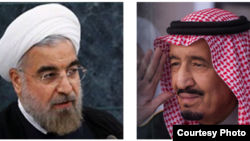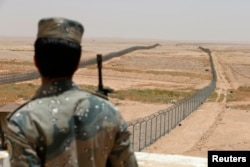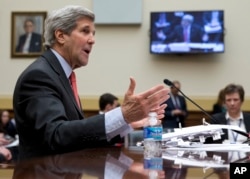After years of mutual mistrust and jockeying for regional power, Saudi Arabia and Iran may be on their way to mending fences, analysts say.
Mutual concerns over the emergence of the so-called Islamic State group in the region and Iran’s impending nuclear deal with the West are providing stimulus for Riyadh and Tehran to head towards détente, analysts say.
“If there is a deal on the nuclear issue, then this will bring Iran back as a participant in the dynamics of the international community, which will force it to become more pragmatic and more moderate,” said Lina Khatib, director of the Carnegie Middle East Center in Beirut. “And this is in Saudi Arabia’s interests because the more extreme Iran becomes, the more threatening it becomes.”
From friends to rivals
Saudi Arabia is a conservative Sunni Islamic kingdom, home to Islam’s holiest sites, Mecca and Medina. As such, it regards itself as the rightful leader of the Islamic world.
Iran is a Shi’ite Islamic republic, which has sought to exert religious influence over Shia populations elsewhere in the region.
Some four decades ago, both countries were relatively politically aligned and had friendly relations with the West. But things changed after the 1979 revolution in Iran and the return of exiled Ayatollah Rouhollah Mousavi Khomeini, who resented the Saudi kingdom’s relationship with the West.
“The Islamic Republic quickly started exporting the revolution in the Middle East,” said Khatib. “They were trying to get Shia populations in the region to accept the supreme leader’s [Khomeini’s] model of Islamic jurisprudence as the only acceptable political and religious model for [the] population.”
Saudi Arabia saw this as a challenge to its own influence as a regional actor in the Middle East.
“Iran’s concern about Saudi Arabia is similar to Saudi Arabia’s concern about Iran. Both these countries are using theocracy as a basis for increasing and expanding political influence,” Khatib added.
Conspiracy fears
And in the end, the rivalry between Riyadh and Tehran is about far more than religion, said Alireza Nader, a senior international policy analyst at RAND and author of Iran After the Bomb.
“The Saudis thought, especially during the Shah's regime, that the United States favored Iran in the region over Saudi Arabia, and there is a persistent Saudi fear to this day that the United States and Iran might work behind Saudi Arabia’s back and come to a secret agreement that leaves the Saudis in the cold,” said Nader.
"There is also a long ethnic component," said Fahad Nazer, terrorism analyst at JTG Inc. and a former political analyst at the Embassy of Saudi Arabia in Washington, D.C., "in terms of Arabs versus Persians. But really, what I think it comes down to more than anything else is more geostrategic differences."
Experts generally agree that whatever the crisis in the Middle East over the past thirty years—Israeli-Palestinian tensions, the Iran-Iraq War, the Gulf and Iraq Wars, Syria’s civil war, the rise of the Islamic State or the recent Houthi takeover in Yemen--there always seems to be a degree of Saudi and Iranian involvement, always on opposite sides.
"I think the involvement of Iran in Yemen and the fairly well-documented support for the Houthis really adds another element to this conflict and really reinforces this idea that Iran is if anything expanding its encroachment, meddling in the region and...slowly but suredly trying to encircle the Arab Gulf countries," Nazer said.
The rivalry is especially evident in present-day Iraq and Syria, said RAND's Nader.
“The conflicts in Iraq and Syria are being fueled by Iran and Saudi Arabia…Iran backs Shia militias in Iraq and it’s a big supporter of the Bashar al-Assad regime in Syria and Hezbollah in Lebanon,” he added.
At the same time, he said, the Saudis support Sunni groups in Lebanon and they also are among some of the biggest backers of the Sunni-led insurgency in Syria.
New commonality
“Today, both countries are suffering the blowback of their rivalry, particularly Iran,” says Nader. “For example, low oil prices that are in part attributed to Saudi policy on oil exports and are really further damaging Iran’s economy. And Saudi Arabia is facing tremendous insecurity over [the] Houthi Shia takeover of the Yemeni government.”
And for the first time, Iran and Saudi Arabia face a common enemy at their borders—the Islamic State, which, as the militant group has made clear, has long-term ambitions for the region as a “state project.”
“ISIS is an extremist Sunni organization that poses a direct challenge to Iran’s Shi’ism, because it regards the Shia as apostates,” says Carnegie’s Khatib, using another shorthand name for the group. “At the same time, ISIS is presenting itself as the true version of Wahhabism, which is a true challenge to Saudi Arabia’s interpretation of Islam, and that means ISIS threatens Saudi Arabia’s claims to religious legitimacy.”
Observers agree that, as the Islamic State grows, in terms of influence, membership and military strength, it ultimately threatens everything that the Saudis and Iranians have worked to achieve.
Looking to co-exist
In view of the realities on the ground there has been a spurt in renewed communication between Riyadh and Tehran, signaling an apparent bilateral interest in thawing chilly relations.
Iran's deputy foreign minister met with the Saudi foreign minister in Jeddah last August for the first high-level talks between the two countries since Hassan Rouhani was elected Iran’s president in 2013. One month later, their respective foreign ministers met on the sidelines of the U.N. General Assembly in New York.
“I think that both sides have come to terms with the fact that neither government or regime is going to go away any time soon, and that they have to find a way to co-exist,” said Nazer. “The basic rules of the game have been established, and that would explain why there hasn’t been any outbreak of direct violence, obviously, or a conflict between the two.”
Some analysts believe that if Western powers reach a successful nuclear deal with Iran, it might help reduce mistrust between Riyadh and Tehran, and pave the way to warmer relations, ultimately altering the dynamics in the entire region.
Some ‘ifs’ remain
But there are still a lot of ifs.
“If the Saudis come to believe that the deal isn’t that bad and that a lessening of tensions between the U.S. and Iran could be beneficial to their interests,” Nader said, “and if they view that they can come to an accommodation with Iran in the region—that one country isn’t going to surpass the other but will have to live with each other and their respective areas of influence, then I think there is still a possibility that we could see a warming of relations between Saudi Arabia and Iran.”
A nuclear deal would benefit Iran because it would lessen the economic burden of sanctions.
However, Khatib warns that Iran will not accept just any deal. It needs a deal that will help it save face when it comes to Saudi Arabia—and saving face is very important to Tehran.
This is where Khatib sees the United States as playing a pivotal role.
“The U.S. is leading the nuclear negotiations with Iran and has indicated that it is serious about reaching a deal,” says she, “and the U.S. needs to continue trying to earn Iranian trust on this matter.
This week, after months of negotiations, officials reported they may be close to reaching a framework deal by early March, opening the door for a final accord to be hammered out by July 1, the agreed upon deadline.









